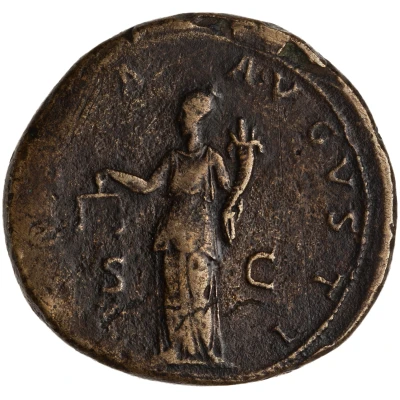


© American Numismatic Society (ANS)
Sestertius - Hadrian MONETA AVGVSTI S C; Moneta
| Orichalcum | 25 g | 32.5 mm |
| Issuer | Rome › Roman Empire (27 BC - 395 AD) |
|---|---|
| Emperor | Hadrian (Publius Aelius Hadrianus) (117-138) |
| Type | Standard circulation coin |
| Years | 120-121 |
| Value | 1 Sestertius = ¼ Denarius |
| Currency | Denarius, Reform of Augustus (27 BC – AD 215) |
| Composition | Orichalcum |
| Weight | 25 g |
| Diameter | 32.5 mm |
| Shape | Round (irregular) |
| Technique | Hammered |
| Demonetized | Yes |
| Updated | 2024-10-06 |
| Numista | N#254992 |
|---|---|
| Rarity index | 97% |
Reverse
Moneta standing left, holding scales and cornucopia.
Script: Latin
Lettering:
MONETA AVGVSTI
S C
Translation:
Moneta Augusti. Senatus Consultum.
The mint of the emperor. Decree of the senate.
Comment
Source: Online Coins of the Roman Empire (OCRE)Interesting fact
The Sestertius coin , which features Emperor Hadrian, is notable for its depiction of the Roman goddess Moneta on the reverse side. Moneta was the goddess of money, currency, and the minting process, and her image on the coin serves as a symbol of the Roman Empire's economic power and influence. The coin's design also includes the inscription "MONETA AVGVSTI S C," which translates to "the mint of the Augustus," further emphasizing the connection between the coinage and the Roman emperor. This coin is a fascinating example of how ancient civilizations used their currency to convey their values, beliefs, and political ideologies.